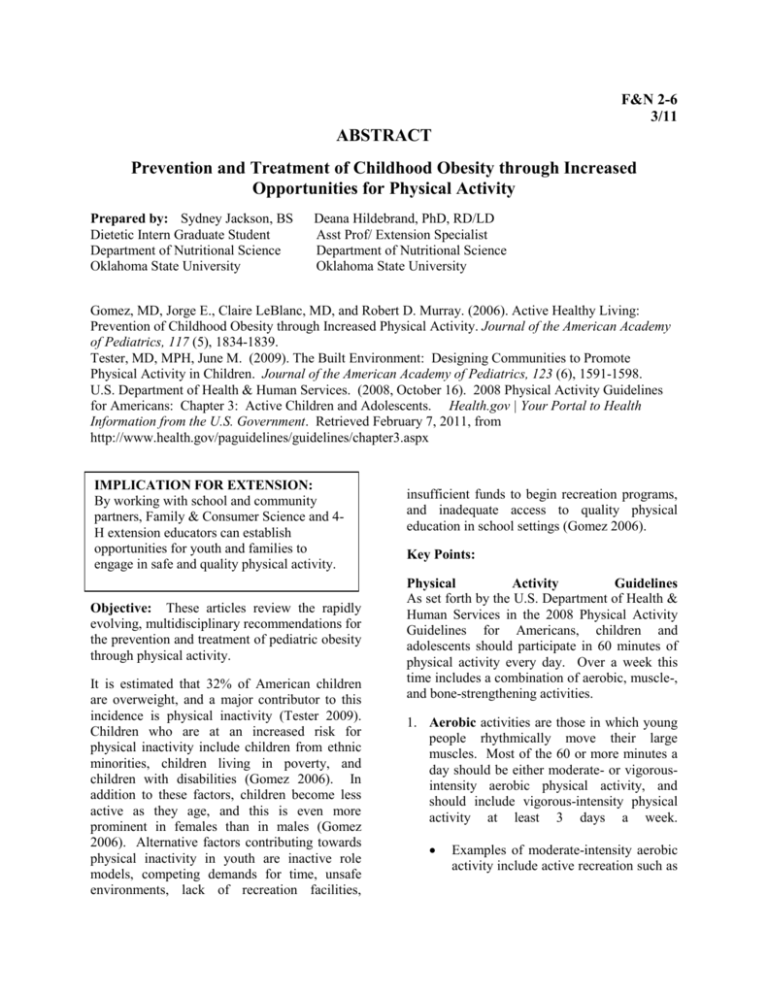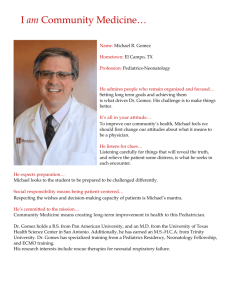Childhood Obesity and Physical Activity
advertisement

F&N 2-6 3/11 ABSTRACT Prevention and Treatment of Childhood Obesity through Increased Opportunities for Physical Activity Prepared by: Sydney Jackson, BS Dietetic Intern Graduate Student Department of Nutritional Science Oklahoma State University Deana Hildebrand, PhD, RD/LD Asst Prof/ Extension Specialist Department of Nutritional Science Oklahoma State University Gomez, MD, Jorge E., Claire LeBlanc, MD, and Robert D. Murray. (2006). Active Healthy Living: Prevention of Childhood Obesity through Increased Physical Activity. Journal of the American Academy of Pediatrics, 117 (5), 1834-1839. Tester, MD, MPH, June M. (2009). The Built Environment: Designing Communities to Promote Physical Activity in Children. Journal of the American Academy of Pediatrics, 123 (6), 1591-1598. U.S. Department of Health & Human Services. (2008, October 16). 2008 Physical Activity Guidelines for Americans: Chapter 3: Active Children and Adolescents. Health.gov | Your Portal to Health Information from the U.S. Government. Retrieved February 7, 2011, from http://www.health.gov/paguidelines/guidelines/chapter3.aspx IMPLICATION FOR EXTENSION: By working with school and community partners, Family & Consumer Science and 4H extension educators can establish opportunities for youth and families to engage in safe and quality physical activity. Objective: These articles review the rapidly evolving, multidisciplinary recommendations for the prevention and treatment of pediatric obesity through physical activity. It is estimated that 32% of American children are overweight, and a major contributor to this incidence is physical inactivity (Tester 2009). Children who are at an increased risk for physical inactivity include children from ethnic minorities, children living in poverty, and children with disabilities (Gomez 2006). In addition to these factors, children become less active as they age, and this is even more prominent in females than in males (Gomez 2006). Alternative factors contributing towards physical inactivity in youth are inactive role models, competing demands for time, unsafe environments, lack of recreation facilities, insufficient funds to begin recreation programs, and inadequate access to quality physical education in school settings (Gomez 2006). Key Points: Physical Activity Guidelines As set forth by the U.S. Department of Health & Human Services in the 2008 Physical Activity Guidelines for Americans, children and adolescents should participate in 60 minutes of physical activity every day. Over a week this time includes a combination of aerobic, muscle-, and bone-strengthening activities. 1. Aerobic activities are those in which young people rhythmically move their large muscles. Most of the 60 or more minutes a day should be either moderate- or vigorousintensity aerobic physical activity, and should include vigorous-intensity physical activity at least 3 days a week. Examples of moderate-intensity aerobic activity include active recreation such as hiking, skateboarding, rollerblading, bicycling and brisk walking. Examples of vigorous-intensity aerobic activity include games involving running and chasing, jumping rope, martial arts, running, and sports such as basketball, soccer, swimming, and tennis. 2. Muscle-strengthening activities make muscles do more work than usual during activities of daily life, and they can be either structured or unstructured. As part of their 60 or more minutes of daily physical activity, children and adolescents should include muscle-strengthening physical activity on at least 3 days of the week. Structured examples include lifting weights and working with resistance bands. Unstructured examples include playing on playground equipment, climbing trees, and playing tug-of-war. 3. Bone-strengthening activities produce a force on the bones that promotes bone growth and strength commonly produced by impact with the ground. As part of their 60 or more minutes of daily physical activity, children and adolescents should include bone-strengthening physical activity on at least 3 days of the week. Examples include running, jumping rope, games such as hopscotch, and sports such as basketball, volleyball, gymnastics, and tennis. Physical Activity in Schools The National Association of State School Boards of Education recommends 150 minutes of physical education weekly for elementary school age students. For students in middle and high schools, 225 minutes per week is recommended (Gomez 2006). In many school settings, these recommendations are not being met, and when they are, the quality of physical education is frequently lacking. That is, students may not be engaged in at least moderateintensity activities for the full time period. Benefits of Physical Activity in the Prevention & Treatment of Childhood Obesity As a measure of prevention, the American Academy of Pediatrics recommends no more than 2 hours of quality television programming per day for children older than 2 years (Gomez 2006). It has also been shown that lifestyle-related physical activity, as opposed to calisthenics or programmed aerobic exercise, is more beneficial for sustained weight loss (Gomez 2006). Treatment programs for overweight and obese children that include a physical activity component in addition to diet modifications have shown to have higher success rates than diet modifications alone (Gomez 2006). In addition, benefits of physical activity include increased insulin sensitivity and reduced blood pressure in children with hypertension. Other important benefits of physical activity for children are increased self-esteem and selfconcept and a decrease in anxiety and depression (Gomez 2006). Guidelines for Increasing Physical Activity Children and adolescents who do not meet the guidelines should slowly increase their activity in small steps and in ways that they enjoy. A gradual increase in the number of days and the time spent being active will help reduce the risk of injury (USDHHS 2008). Children and adolescents who meet the guidelines should continue being active on a daily basis and, if appropriate, become even more active. Evidence suggests that even more than 60 minutes of activity every day may provide additional health benefits (USDHHS 2008). Children and adolescents who exceed the guidelines should maintain their activity level and vary the kinds of activities they do to reduce the risk of overtraining or injury (USDHHS 2008). Promoting Physical Activity in the Community Environment Multiple factors influence a child’s level of physical activity including individual selfefficacy, family role models and support, social norms, and the physical design of the community within which they live. Environments that promote more active lifestyles are essential for children and adolescents to achieve the physical activity recommendations described above. Opportunities for recreational physical activity arise with parks and green spaces. There is a direct relation between the proximity to a park and a child’s time spent in physical activity. Greater percentage of park area in a child’s neighborhood has also been shown to increase the level of physical activity. Examples of successful strategies to promote public space include converting previously unused areas into parks and playgrounds. Legislative efforts are also an important mechanism to the successful promotion of public spaces. Community gardens have arisen from such efforts (Tester 2009). Gardens not only provide a source of healthful, affordable foods but also provide opportunity for family-centered physical activity. Additionally, access to sidewalks and proximity of neighborhood shops and schools to residences provide valuable opportunities for activity. Closer proximity to school also provides the opportunity for use of school grounds for physical activity in afterschool hours (Tester 2009). Furthermore, the presence of sidewalks is protective to pedestrians. Another way to offer pedestrian protection is through “traffic calming”, which can be applied to roads to slow driver speed. Many communities are working to make physical activity more accessible and safe (Tester 2009). Examples of increasing walking and biking to school include the “Safe Routes to Schools” and “Walking School Buses” programs. Safety concerns play an important role and contribute to inactivity. Signs of disorderly neighborhoods such as broken windows and abandoned buildings give the perception and fear of crime. When these characterize school property children are more likely to feel unsafe at school (Tester 2009).




